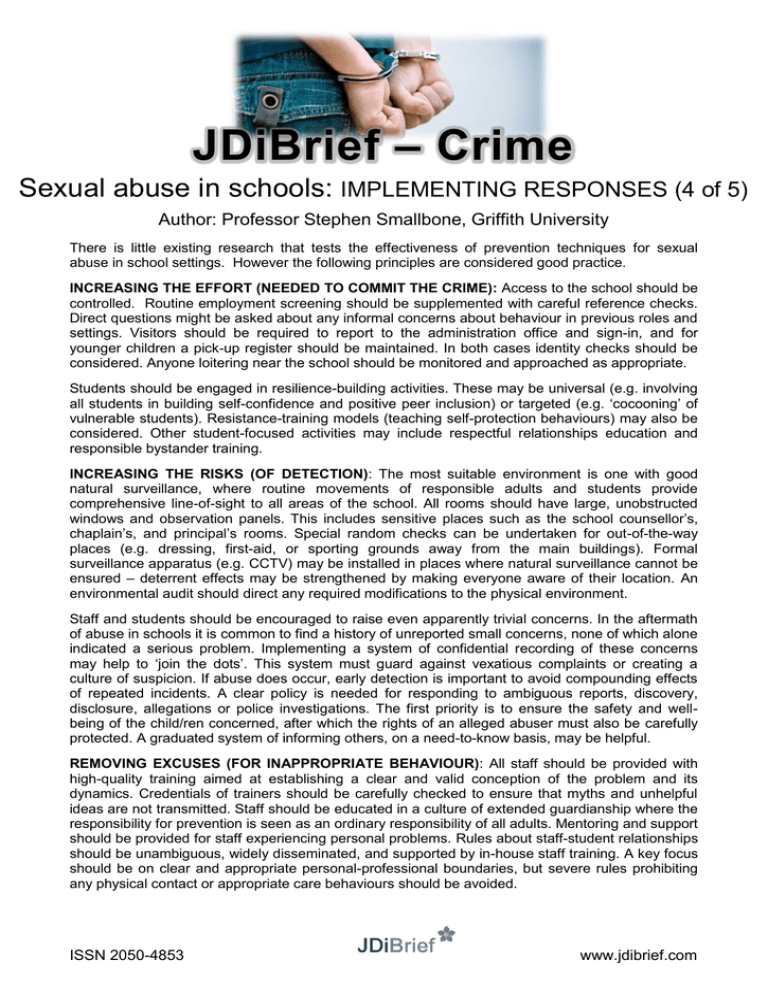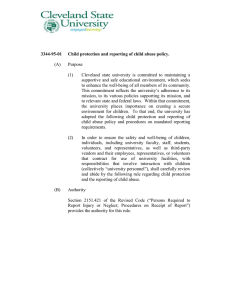
JDiBrief – Crime
Sexual abuse in schools: IMPLEMENTING RESPONSES (4 of 5)
Author: Professor Stephen Smallbone, Griffith University
There is little existing research that tests the effectiveness of prevention techniques for sexual
abuse in school settings. However the following principles are considered good practice.
INCREASING THE EFFORT (NEEDED TO COMMIT THE CRIME): Access to the school should be
controlled. Routine employment screening should be supplemented with careful reference checks.
Direct questions might be asked about any informal concerns about behaviour in previous roles and
settings. Visitors should be required to report to the administration office and sign-in, and for
younger children a pick-up register should be maintained. In both cases identity checks should be
considered. Anyone loitering near the school should be monitored and approached as appropriate.
Students should be engaged in resilience-building activities. These may be universal (e.g. involving
all students in building self-confidence and positive peer inclusion) or targeted (e.g. ‘cocooning’ of
vulnerable students). Resistance-training models (teaching self-protection behaviours) may also be
considered. Other student-focused activities may include respectful relationships education and
responsible bystander training.
INCREASING THE RISKS (OF DETECTION): The most suitable environment is one with good
natural surveillance, where routine movements of responsible adults and students provide
comprehensive line-of-sight to all areas of the school. All rooms should have large, unobstructed
windows and observation panels. This includes sensitive places such as the school counsellor’s,
chaplain’s, and principal’s rooms. Special random checks can be undertaken for out-of-the-way
places (e.g. dressing, first-aid, or sporting grounds away from the main buildings). Formal
surveillance apparatus (e.g. CCTV) may be installed in places where natural surveillance cannot be
ensured – deterrent effects may be strengthened by making everyone aware of their location. An
environmental audit should direct any required modifications to the physical environment.
Staff and students should be encouraged to raise even apparently trivial concerns. In the aftermath
of abuse in schools it is common to find a history of unreported small concerns, none of which alone
indicated a serious problem. Implementing a system of confidential recording of these concerns
may help to ‘join the dots’. This system must guard against vexatious complaints or creating a
culture of suspicion. If abuse does occur, early detection is important to avoid compounding effects
of repeated incidents. A clear policy is needed for responding to ambiguous reports, discovery,
disclosure, allegations or police investigations. The first priority is to ensure the safety and wellbeing of the child/ren concerned, after which the rights of an alleged abuser must also be carefully
protected. A graduated system of informing others, on a need-to-know basis, may be helpful.
REMOVING EXCUSES (FOR INAPPROPRIATE BEHAVIOUR): All staff should be provided with
high-quality training aimed at establishing a clear and valid conception of the problem and its
dynamics. Credentials of trainers should be carefully checked to ensure that myths and unhelpful
ideas are not transmitted. Staff should be educated in a culture of extended guardianship where the
responsibility for prevention is seen as an ordinary responsibility of all adults. Mentoring and support
should be provided for staff experiencing personal problems. Rules about staff-student relationships
should be unambiguous, widely disseminated, and supported by in-house staff training. A key focus
should be on clear and appropriate personal-professional boundaries, but severe rules prohibiting
any physical contact or appropriate care behaviours should be avoided.
ISSN 2050-4853
www.jdibrief.com







